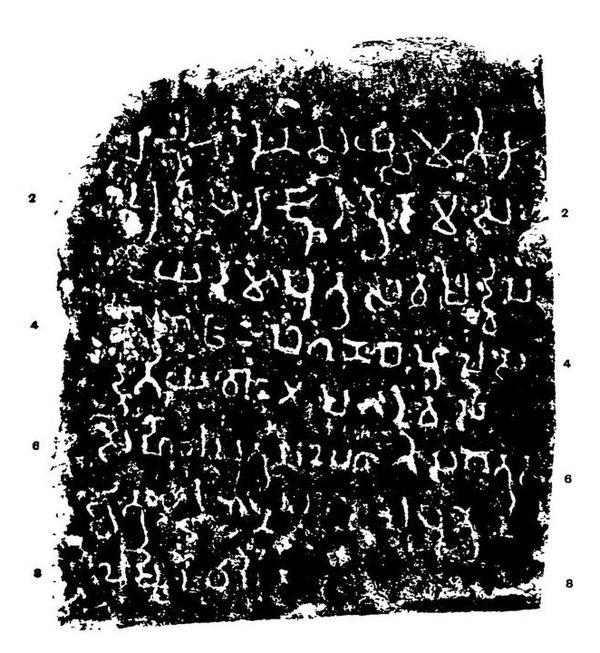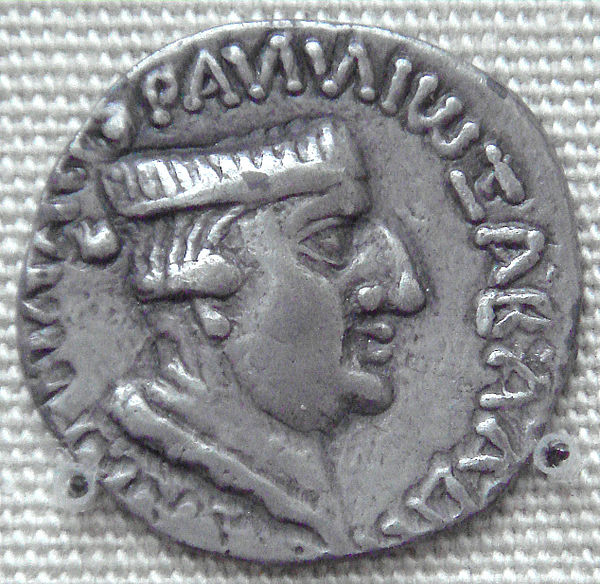Rudradaman I
Videos
Page
Rudradāman I was a Śaka ruler from the Western Kshatrapas dynasty. He was the grandson of the king Caṣṭana. Rudradāman I was instrumental in the decline of the Sātavāhana Empire. Rudradāman I took up the title of Maha-kshtrapa, after he became the king and then strengthened his kingdom.

Rudradāman I coin, with corrupted Greek legend. British Museum.

Andhau stone inscription of the time of Rudradāman, Śaka Year 52 (130 CE). The inscription reads: "In the year fifty-two, 50, 2; on the second day of the dark half of Phaguna, of (the reign of) the king Rudradāman, son of Jayadaman, (who was the grandson) of the king Caṣṭana, son of Ysamotika, (this) staff was raised in memory of Rishabhadeva, son of Sihila, of the Opasati gotra, by (his) brother, Madana, son of Sihila."

Genealogical stone inscription of Rudradāman: "Ghsamotika, his son rajan mahakshatrapa svamin Caṣṭana, his son rajan svamin Jayadāman, and his son rajan svamin Rudradaman." Khavada , Kutch district.

The Junagadh rock contains inscriptions by Ashoka (fourteen of the Edicts of Ashoka), Rudradāman I and Skandagupta.
Western Satraps
Videos
Page
The Western Satraps, or Western Kshatrapas were Indo-Scythian (Saka) rulers of the western and central parts of India, between 35 and 415 CE. The Western Satraps were contemporaneous with the Kushans who ruled the northern part of the Indian subcontinent, and were possibly vassals of the Kushans. They were also contemporaneous with the Satavahana (Andhra) who ruled in Central India. They are called "Western Satraps" in modern historiography in order to differentiate them from the "Northern Satraps", who ruled in Punjab and Mathura until the 2nd century CE.

Coin of Bhumaka (?–119). Obv: Arrow, pellet, and thunderbolt. Kharoshthi inscription Chaharasada Chatrapasa Bhumakasa: "Ksaharata Satrap Bhumaka". Rev: Capital of a pillar with seated lion with upraised paw, and wheel (dharmachakra). Brahmi inscription: Kshaharatasa Kshatrapasa Bhumakasa.

Coin of Nahapana (whose rule is variously dated to 24-70 CE, 66-71 CE, or 119–124 CE), a direct derivation from Indo-Greek coinage. British Museum.

The Greco-Prakrit title "RANNIO KSAHARATA" ("ΡΑΝΝΙω ΞΑΗΑΡΑΤΑ(Ϲ)", Prakrit for "King Kshaharata" rendered in corrupted Greek letters) on the obverse of the coinage of Nahapana.

Hall of the Great Chaitya Cave at Karla (120 CE)